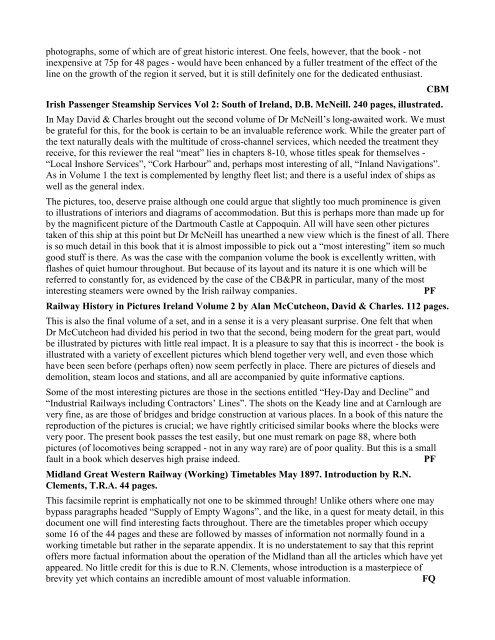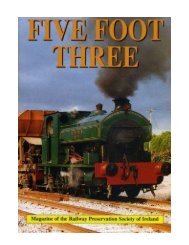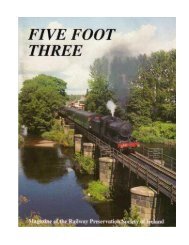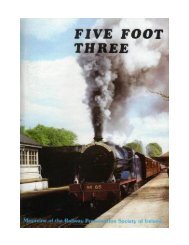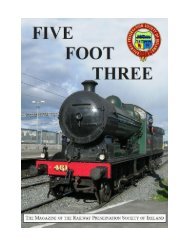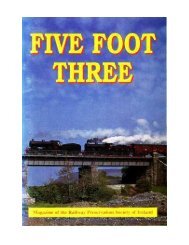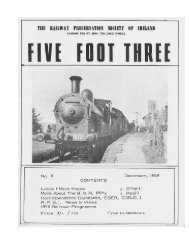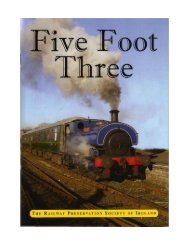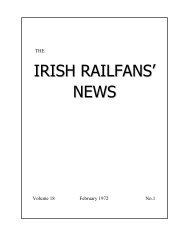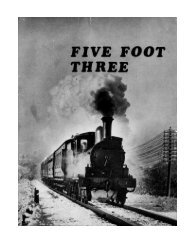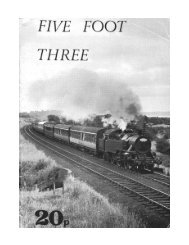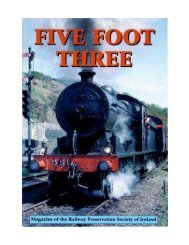No.3 - Steam trains on Irish Railways with RPSI - Railway
No.3 - Steam trains on Irish Railways with RPSI - Railway
No.3 - Steam trains on Irish Railways with RPSI - Railway
Create successful ePaper yourself
Turn your PDF publications into a flip-book with our unique Google optimized e-Paper software.
photographs, some of which are of great historic interest. One feels, however, that the book - notinexpensive at 75p for 48 pages - would have been enhanced by a fuller treatment of the effect of theline <strong>on</strong> the growth of the regi<strong>on</strong> it served, but it is still definitely <strong>on</strong>e for the dedicated enthusiast.<strong>Irish</strong> Passenger <str<strong>on</strong>g>Steam</str<strong>on</strong>g>ship Services Vol 2: South of Ireland, D.B. McNeill. 240 pages, illustrated.In May David & Charles brought out the sec<strong>on</strong>d volume of Dr McNeill’s l<strong>on</strong>g-awaited work. We mustbe grateful for this, for the book is certain to be an invaluable reference work. While the greater part ofthe text naturally deals <strong>with</strong> the multitude of cross-channel services, which needed the treatment theyreceive, for this reviewer the real “meat” lies in chapters 8-10, whose titles speak for themselves -“Local Inshore Services”, “Cork Harbour” and, perhaps most interesting of all, “Inland Navigati<strong>on</strong>s”.As in Volume 1 the text is complemented by lengthy fleet list; and there is a useful index of ships aswell as the general index.CBMThe pictures, too, deserve praise although <strong>on</strong>e could argue that slightly too much prominence is givento illustrati<strong>on</strong>s of interiors and diagrams of accommodati<strong>on</strong>. But this is perhaps more than made up forby the magnificent picture of the Dartmouth Castle at Cappoquin. All will have seen other picturestaken of this ship at this point but Dr McNeill has unearthed a new view which is the finest of all. Thereis so much detail in this book that it is almost impossible to pick out a “most interesting” item so muchgood stuff is there. As was the case <strong>with</strong> the compani<strong>on</strong> volume the book is excellently written, <strong>with</strong>flashes of quiet humour throughout. But because of its layout and its nature it is <strong>on</strong>e which will bereferred to c<strong>on</strong>stantly for, as evidenced by the case of the CB&PR in particular, many of the mostinteresting steamers were owned by the <strong>Irish</strong> railway companies.PF<strong>Railway</strong> History in Pictures Ireland Volume 2 by Alan McCutche<strong>on</strong>, David & Charles. 112 pages.This is also the final volume of a set, and in a sense it is a very pleasant surprise. One felt that whenDr McCutche<strong>on</strong> had divided his period in two that the sec<strong>on</strong>d, being modern for the great part, wouldbe illustrated by pictures <strong>with</strong> little real impact. It is a pleasure to say that this is incorrect - the book isillustrated <strong>with</strong> a variety of excellent pictures which blend together very well, and even those whichhave been seen before (perhaps often) now seem perfectly in place. There are pictures of diesels anddemoliti<strong>on</strong>, steam locos and stati<strong>on</strong>s, and all are accompanied by quite informative capti<strong>on</strong>s.Some of the most interesting pictures are those in the secti<strong>on</strong>s entitled “Hey-Day and Decline” and“Industrial <strong><strong>Railway</strong>s</strong> including C<strong>on</strong>tractors’ Lines”. The shots <strong>on</strong> the Keady line and at Carnlough arevery fine, as are those of bridges and bridge c<strong>on</strong>structi<strong>on</strong> at various places. In a book of this nature thereproducti<strong>on</strong> of the pictures is crucial; we have rightly criticised similar books where the blocks werevery poor. The present book passes the test easily, but <strong>on</strong>e must remark <strong>on</strong> page 88, where bothpictures (of locomotives being scrapped - not in any way rare) are of poor quality. But this is a smallfault in a book which deserves high praise indeed.PFMidland Great Western <strong>Railway</strong> (Working) Timetables May 1897. Introducti<strong>on</strong> by R.N.Clements, T.R.A. 44 pages.This facsimile reprint is emphatically not <strong>on</strong>e to be skimmed through! Unlike others where <strong>on</strong>e maybypass paragraphs headed “Supply of Empty Wag<strong>on</strong>s”, and the like, in a quest for meaty detail, in thisdocument <strong>on</strong>e will find interesting facts throughout. There are the timetables proper which occupysome 16 of the 44 pages and these are followed by masses of informati<strong>on</strong> not normally found in aworking timetable but rather in the separate appendix. It is no understatement to say that this reprintoffers more factual informati<strong>on</strong> about the operati<strong>on</strong> of the Midland than all the articles which have yetappeared. No little credit for this is due to R.N. Clements, whose introducti<strong>on</strong> is a masterpiece ofbrevity yet which c<strong>on</strong>tains an incredible amount of most valuable informati<strong>on</strong>.FQ


